Discover Florida Nature
It's time to explore the natural Florida


|
|
|
|
|
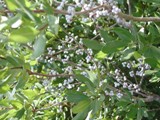 (Wax)
Myrtle (Myrica cerifera)- This beautiful native tree grows in
abundance in Florida. The wax myrtle is semi-evergreen where the winters
are frosty. This popular plant has an attractive rounded form and is
commonly used in landscaping as a small tree or pruned as a shrub. The
simple narrow leaves of the wax myrtle range from 1-5 inches in length
and about 0.5 inch wide. They are gray-green to yellow-green and
aromatic when crushed. Wax myrtle sends up multiple trunks that can grow
to as high as 25 feet and will eventually form a colony if suckers are
not removed. The flowers appear in late winter. The males are
yellow-green catkins that grow up to 1 inch long while the females are
small and inconspicuous little bumps that grow into small blue berries,
1/8 inch in diameter, that are held closely to the stem. (Wax)
Myrtle (Myrica cerifera)- This beautiful native tree grows in
abundance in Florida. The wax myrtle is semi-evergreen where the winters
are frosty. This popular plant has an attractive rounded form and is
commonly used in landscaping as a small tree or pruned as a shrub. The
simple narrow leaves of the wax myrtle range from 1-5 inches in length
and about 0.5 inch wide. They are gray-green to yellow-green and
aromatic when crushed. Wax myrtle sends up multiple trunks that can grow
to as high as 25 feet and will eventually form a colony if suckers are
not removed. The flowers appear in late winter. The males are
yellow-green catkins that grow up to 1 inch long while the females are
small and inconspicuous little bumps that grow into small blue berries,
1/8 inch in diameter, that are held closely to the stem.Oak Trees: Oak trees, along with pine trees are one of the most common types of trees in the state of Florida. Oak trees are an important resource for both birds and mammals. White-tailed deer, turkeys, raccoons, and squirrels feed on the acorns. 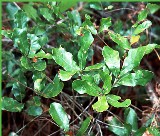 Chapman's Oak (Quercus chapmanii)- Chapman oak is a member of the white oak group that grows in upland scrub habitats of the southeastern United States. The trees have little economic significance but do contribute to the species diversity of forested areas and provide valuable wildlife food and nesting sites. Chapman oak is mostly found near the salt water in the islands of Beaufort County, South Carolina and in central and western Florida. 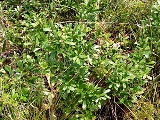 Dwarf
Live Oak
(Quercus minima)- Dwark live oak is a frequent but somewhat uncommon
understory shrub in pine rocklands, mesic flatwoods, scrubby flatwoods,
sandhill and dry
prairie. It is a small woody groundcover with branches usually to 3
feet or less and numerous underground stems. Leaves of the dwarf live
oak are 1-4 inches long. Found mostly in the
pinelands, dwarf like oak
does not tolerate long term flooding by salt or brackish waters. Dwarf
Live Oak
(Quercus minima)- Dwark live oak is a frequent but somewhat uncommon
understory shrub in pine rocklands, mesic flatwoods, scrubby flatwoods,
sandhill and dry
prairie. It is a small woody groundcover with branches usually to 3
feet or less and numerous underground stems. Leaves of the dwarf live
oak are 1-4 inches long. Found mostly in the
pinelands, dwarf like oak
does not tolerate long term flooding by salt or brackish waters.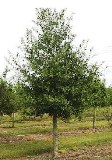 Laurel
Oak (Quercus laurifolia)- Laurel oak is a tree of pleasing
symmetry. It is fast growing, tall, and full. Laurel oak grows scattered
with other hardwoods in well-drained
hammocks near the
edges of streams and rivers. In Florida, it can also be found in
flatwoods and moderately well drained soils. Laurel oak is abundant in
Florida's urban and rural areas and is a common ornamental in other
parts of the south. It also becomes a common component in pine forests
when fire is excluded from those systems. Laurel oak produces large
crops of acorns regularly. Laurel
Oak (Quercus laurifolia)- Laurel oak is a tree of pleasing
symmetry. It is fast growing, tall, and full. Laurel oak grows scattered
with other hardwoods in well-drained
hammocks near the
edges of streams and rivers. In Florida, it can also be found in
flatwoods and moderately well drained soils. Laurel oak is abundant in
Florida's urban and rural areas and is a common ornamental in other
parts of the south. It also becomes a common component in pine forests
when fire is excluded from those systems. Laurel oak produces large
crops of acorns regularly.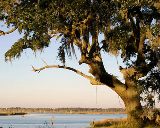 Live
Oak
(Quercus virginiana)-Live oak is a large spreading tree of the lower
Coastal Plain from southeastern Virginia to southern Florida. It
normally grows in low sandy soils near the
Coast but also occurs in moist
rich woods and along stream banks. On the Gulf Coast, live oaks often
support many types of epiphytic plants, including Spanish moss. Live
oak ranks as one of the heaviest native hardwoods, weighing 55 pounds
per cubic foot when air dry. This weight or density makes live oak a
good fuel wood although it can be very difficult to split. Live
Oak
(Quercus virginiana)-Live oak is a large spreading tree of the lower
Coastal Plain from southeastern Virginia to southern Florida. It
normally grows in low sandy soils near the
Coast but also occurs in moist
rich woods and along stream banks. On the Gulf Coast, live oaks often
support many types of epiphytic plants, including Spanish moss. Live
oak ranks as one of the heaviest native hardwoods, weighing 55 pounds
per cubic foot when air dry. This weight or density makes live oak a
good fuel wood although it can be very difficult to split. 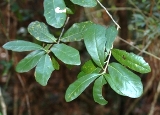 Myrtle
Oak
(Quercus myrtifolia)-Myrtle oak, sometimes called shrubby oak, is a
small, evergreen tree that often grows into unusual, contorted forms due
to exposure to coastal winds. It re-sprouts easily and frequently grows
into dense thickets. Its regenerative ability makes it quick to recover
after a fire. Myrtle oak is usually found close to salt water along the
sandy ridges on the shorelines and islands from South Carolina,
throughout coastal Florida, and west into Mississippi. The acorns from
myrtle oak are ready early in the season and provide an important source
of food for many wildlife. The high carbohydrate, high fat nuts are
eaten by wild turkey, quail, squirrels,
raccoons,
black bear, deer, and numerous
rodents. The dense, thickets provide excellent nesting and cover sites
for birds, including the Florida
scrub jay, an endangered species. Myrtle
Oak
(Quercus myrtifolia)-Myrtle oak, sometimes called shrubby oak, is a
small, evergreen tree that often grows into unusual, contorted forms due
to exposure to coastal winds. It re-sprouts easily and frequently grows
into dense thickets. Its regenerative ability makes it quick to recover
after a fire. Myrtle oak is usually found close to salt water along the
sandy ridges on the shorelines and islands from South Carolina,
throughout coastal Florida, and west into Mississippi. The acorns from
myrtle oak are ready early in the season and provide an important source
of food for many wildlife. The high carbohydrate, high fat nuts are
eaten by wild turkey, quail, squirrels,
raccoons,
black bear, deer, and numerous
rodents. The dense, thickets provide excellent nesting and cover sites
for birds, including the Florida
scrub jay, an endangered species.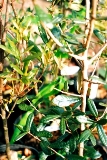 Sand
Live Oak
(Quercus geminata)- The Sand Live Oak Tree can grow as a shrub or bush
on very sandy, poor soils or it can in some cases grow as tall as 70
feet. The leaves of the Sand Live Oak are similar to the Southern Live
Oak in shape and are basically evergreen in most years. The leaves of
the sand live oak tree are bright green and turn downward at the tips
and often hang from the twigs like an inverted boat. The small Sand Live
Oak Shade Tree is very salt water tolerant and is often found in coastal
areas, where it grows up to 20 ft tall. In coastal areas where the trees
are sheared by salt water spray, a large impenetrable, thick growth
emerges from the roots to form a dense copse. Sand
Live Oak
(Quercus geminata)- The Sand Live Oak Tree can grow as a shrub or bush
on very sandy, poor soils or it can in some cases grow as tall as 70
feet. The leaves of the Sand Live Oak are similar to the Southern Live
Oak in shape and are basically evergreen in most years. The leaves of
the sand live oak tree are bright green and turn downward at the tips
and often hang from the twigs like an inverted boat. The small Sand Live
Oak Shade Tree is very salt water tolerant and is often found in coastal
areas, where it grows up to 20 ft tall. In coastal areas where the trees
are sheared by salt water spray, a large impenetrable, thick growth
emerges from the roots to form a dense copse. 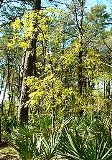 Turkey
Oak (Quercus laevis)- The turkey oak is one of the
characteristic trees associated with the sandhill community over much of
Florida. It is abundant and reaches good size on dry sandy ridges, sandy
bluffs, and hammocks of the coastal region. The common name refers to
the shape of the three lobed leaves that resemble a turkey's foot. The
Latin species name laevis means smooth and describes the nearly
hairless leaves. The turkey oak may be considered a weed tree in certain
areas of Florida. The wood is heavy, hard, strong, and light brown in
color with a light red tint. Turkey
Oak (Quercus laevis)- The turkey oak is one of the
characteristic trees associated with the sandhill community over much of
Florida. It is abundant and reaches good size on dry sandy ridges, sandy
bluffs, and hammocks of the coastal region. The common name refers to
the shape of the three lobed leaves that resemble a turkey's foot. The
Latin species name laevis means smooth and describes the nearly
hairless leaves. The turkey oak may be considered a weed tree in certain
areas of Florida. The wood is heavy, hard, strong, and light brown in
color with a light red tint.
|
|
|
Advertise | Privacy Statement | Dog Encyclopedia | Video |Contact | Alaska Nature |
|